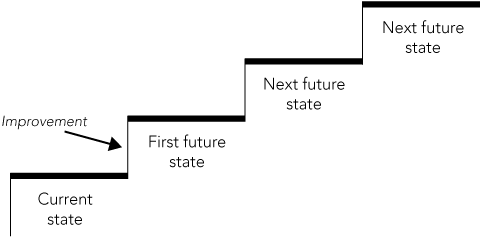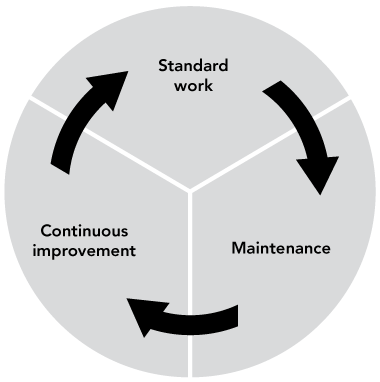NSW Health and Flinders Medical Centre (FMC) in South Australia have been undertaking clinical process redesign projects since August 2004 and November 2003, respectively. In response to local needs and conditions, there have been variations in the way these redesign projects have been carried out. The common principles for successful implementation and sustainability that have emerged from our experience are listed below. They are supported by evidence from overseas programs undertaking similar reforms, particularly the National Health Service in the United Kingdom1 and the Institute for Healthcare Improvement in the United States.2
Visible involvement of the chief executive and senior management is essential.3 Senior management needs to set the standards for service delivery and drive the change process. This requires management to engage and challenge staff with “stretch goals” (ambitious goals that stimulate staff beyond their current achievements), set the parameters for acceptable solutions, ensure strategies are implemented within set timeframes and budgets, monitor performance, and reward success. Staff members need to see that the program is a priority for their chief executive officer. To succeed in the face of obstacles and setbacks, resistance, or failure of certain elements of the project, senior managers need to be resilient and keep the momentum going.
The experience at FMC (→ Redesigning care at the Flinders Medical Centre: clinical process redesign using lean thinking)4 has highlighted the significant benefits of having the executive team at hospital level directly involved in the redesign. FMC found it valuable to have senior clinicians and executives involved in tracking patient journeys and in clinical work. This has helped take redesign from being a project to being part of what staff do every day.
A core focus of the clinical redesign process is the patient journey for groups of patients with similar service delivery needs. These groupings are broader than disease-based classifications. They are defined by grouping together patients with similar journeys, such as patients who visit the emergency department and then return home, frail older patients with multiple comorbid conditions, or relatively fit patients in hospital for day-only procedures. Understanding patient demand and standardising patient journeys will assist in simplifying the redesign process, so that the steps in a journey are readily known and understood by staff and able to be easily communicated to patients. Standard processes (a “lean thinking” concept5) are robust in design, less prone to error and are easy to teach to new staff. They should become second nature to staff and be easily integrated into information technology systems.
While some of the necessary data can be collected on paper or in simple databases, the redesign process has highlighted the need for much better data management systems. Ultimately, we have learnt that information technology systems that deliver relevant information to frontline managers are essential for achieving high-quality, efficient patient journeys (Box 1).
As outlined in other articles in this supplement, both NSW Health (→ Patient journeys: the process of clinical redesign)6 and FMC (→ Redesigning care at the Flinders Medical Centre: clinical process redesign using lean thinking)4 created a central group to manage their overall redesign programs. In NSW, this involved many hospitals across the state, whereas FMC is a single medical centre. In both places, there was recognition that the redesign process was a method that had been widely and successfully applied in other industries5 and there was a need to learn from or directly involve experts in redesign. FMC staff attended an external course to learn the redesign principles, whereas NSW Health engaged external consultants. The NSW statewide project delivered a significant return on this investment for NSW Health by reducing length of stay for patients.
In both cases, strong program management, both centrally and at the level of individual projects, was essential. In NSW, the use of external facilitators (→ Patient journeys: the process of clinical redesign)6 was a powerful tool in breaking down the “silo” mentality and facilitating multidisciplinary teamwork. Their expertise in change management and in establishing data charts was exceptionally helpful in driving change. It was also essential to get the process up and running in multiple sites, where management and clinicians were often uncertain as to the benefits of the program.
The type of clinical process redesign methods we have described in this supplement work best at local hospital or unit level. A different approach is required to simultaneously run redesign projects across a number of hospitals. Nevertheless, our experience has shown that it is possible to do this with careful planning and well coordinated central program management. This has been demonstrated by the experience in NSW Health, by the Department of Health in the UK1 and in the “100 000 Lives” campaign of the US Institute for Healthcare Improvement.2
Knowledge sharing between teams was essential. It was achieved through workshops, online communities of interest and through the database of the Australian Resource Centre for Healthcare Innovations.7
It does not matter which improvement method or model (lean thinking,5 six sigma,8 or theory of constraints9) is used in the redesign process, as long as it is applied with rigour and persistence. We have found that there needs to be constancy of purpose by all those involved in clinical process redesign.
It is important to recognise that the redesign projects are not controlled trials, but are more akin to action research10 in that they are not designed to be perfect or dictated by strict protocols, but rather to be iterative and flexible as the need arises. In fact, it is crucial to their success that they are modifiable in response to data, as well as to staff and patient feedback. The plan-do-study-act11 method (testing a change by planning it, trying it, observing the results, and acting on what is discovered) is ideal for a flexible improvement model and allows reflective learning from one intervention to feed into the next.
Sustainability, in our experience, is the most challenging phase of clinical process redesign. It is best depicted as a staircase, which demonstrates the notion that redesign is, by nature, continuous (Box 2).
With this in mind, how should we approach sustainability? Our view is that it should be thought about as a dynamic process containing three main elements — standard work, maintenance and continuous improvement (Box 3).
Standard work occurs at the end of successful implementation. The new processes (standard work) must be documented, and various roles defined and made explicit, especially with new or temporary staff. An important part of standard work is removing variation in the way a process is done. The performance of individuals and the team must then be monitored to ensure procedures are being performed as expected (Box 4).
Growing demand and technological change requires us to constantly improve to maintain standards. A regular forum where performance and process issues are discussed with stakeholders from across the patient journey is an ideal mechanism to promote ongoing improvement. The output of these forums should provide the next opportunity to redesign and improve the journey (Box 5).
- 1. United Kingdom Department of Health. Policy and guidance. Organisation policy. Health reform. http://www.dh.gov.uk/en/Policyandguidance/Organisationpolicy/Healthreform/index.htm (accessed Sep 2007).
- 2. Nolan TW. Execution of strategic improvement initiatives to produce system-level results. IHI Innovation Series white paper. Cambridge, Mass: Institute for Healthcare Improvement, 2007. http://www.ihi.org/IHI/Results/WhitePapers/ExecutionofStrategicImprovementInitiativesWhitePaper.htm (accessed Jan 2008).
- 3. Kotter JP. Leading change. Boston: Harvard Business School Press, 1996.
- 4. Ben-Tovim DI, Bassham JE, Bennett DM, et al. Redesigning care at the Flinders Medical Centre: clinical process redesign using “lean thinking”. Med J Aust 2008; 188 (5 Suppl): S27-S31. <MJA full text>
- 5. Womack J, Jones D. Lean thinking. Banish waste and create wealth in your corporation. London: Simon and Schuster, 1998.
- 6. Ben-Tovim DI, Dougherty ML, O’Connell TJ, McGrath KM. Patient journeys: the process of clinical redesign. Med J Aust 2008; 188 (5 Suppl): S14-S17. <MJA full text>
- 7. Australian Resource Centre for Healthcare Innovations [website]. http://www.archi.net.au (accessed Sep 2007).
- 8. Mikel H. Mikel Harry on six sigma in healthcare. Interview by Carole S. Guinane. J Healthc Qual 2006; 28: 29-36.
- 9. Goldratt EM. Theory of constraints. New York: North River, 1999. http://www.coba.usf.edu/departments/accounting/faculty/jozsi/presentations%20fall06/TOC.pdf (accessed Sep 2007).
- 10. Reason P, Bradbury H, editors. Handbook of action research. London: Sage, 2006.
- 11. Langley GJ, Nolan KM, Norman CL, et al. The improvement guide: a practical approach to enhancing organizational performance. San Francisco: Jossey-Bass Publishers, 1996.







Thanks to Professor John Marley and Dr Deborah Lloyd for their editorial advice on this article, and to Dr Lloyd for her work in the preparation of this supplement.
None identified.